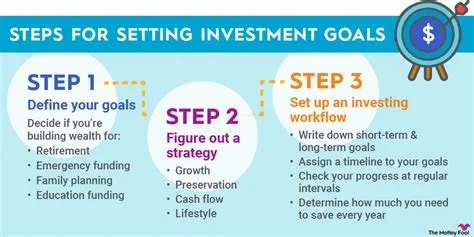Hey there, future financial whiz! Ever feel like you’re just spinning your wheels when it comes to saving and investing? Like trying to climb a mountain with bare hands? Well, I get it. Managing money can feel overwhelming, especially when you think you need a huge starting sum to make a difference. But what if I told you that you could start building a solid financial future with just a few dollars a day? That’s the power of micro-investing-risks">micro-investing-platforms">micro-investing-basics">micro-investing, and today, we’re diving deep into how to set goals that will make it actually work for you.
Think of micro-investing like planting a tiny seed. You might not see a towering oak tree overnight, but with consistent care and attention, that seed will grow into something amazing. The key is to cultivate that growth with carefully planned goals. Without goals, your micro-investing efforts are like a ship sailing without a destination – you might be moving, but you’re not getting anywhere.
Defining Your “Why”: The Foundation of Your Micro-Investing Goals
Before we even talk about specific dollar amounts or investment strategies, let’s talk about why you want to micro-invest. What are your dreams? What are you saving for? This is the crucial first step. Are you saving for a down payment on a house? A dream vacation? Early retirement? A new car? Maybe you’re simply trying to build a safety net for unexpected expenses.
Whatever your reason, writing it down – making it concrete – is incredibly powerful. This isn’t just some abstract idea; it’s your personal North Star guiding your financial journey. The clearer your “why,” the stronger your commitment will be to sticking with your plan, even when things get tough (and they will!). Imagine it like this: your “why” is the fuel that keeps you going when motivation wanes.
SMART Goals: The Blueprint for Micro-Investing Success
Once you’ve defined your “why,” it’s time to set some SMART goals. SMART stands for:
Specific: Instead of saying “I want to save more money,” try “I want to save $50 a month for a down payment on a house.” The more specific, the better.
Measurable: How will you track your progress? Will you use a spreadsheet, a budgeting app, or a dedicated micro-investing app? Make sure you have a way to monitor your success.
Achievable: Set realistic goals based on your income and expenses. Start small and gradually increase your contributions as your finances allow. Don’t try to run a marathon before you can even jog a mile!
Relevant: Make sure your goals align with your overall financial picture and long-term objectives. Don’t set goals that contradict your other financial priorities.
Time-Bound: Set a deadline for achieving your goal. This creates a sense of urgency and helps you stay focused. For example, “I want to save $5,000 for a down payment in two years.”
Examples of SMART Goals for Micro-Investing:
Short-term goal: Save $100 for an emergency fund within six months by investing $20 per week.
Mid-term goal: Save $1,000 for a vacation in one year by investing $83 per month.
Long-term goal: Save $10,000 for a down payment on a house in five years by investing $139 per month.
These are just examples, of course. Your goals will be unique to your circumstances and aspirations.
Choosing the Right Micro-Investing Platform
With your SMART goals in place, the next step is choosing the right platform. Many apps and platforms offer micro-investing options, making it easier than ever to start investing small amounts regularly. Some popular options include:
Robinhood: Known for its user-friendly interface and commission-free trades, Robinhood is a great option for beginners.
Acorns: Acorns rounds up your purchases and invests the spare change, making micro-investing almost effortless.
Stash: Stash offers fractional-shares-basics">fractional-shares-and-wealth-building">fractional-share-platforms">fractional shares, allowing you to invest in even the most expensive stocks with small amounts of money.
Betterment: Betterment provides automated investing services, making it ideal for those who prefer a hands-off approach.
Remember to research different platforms and choose one that aligns with your investment style, risk tolerance, and financial goals. Read reviews, compare fees, and understand the investment options available.
Tracking Your Progress and Staying Motivated
Once you’ve set your goals and chosen a platform, the next – and arguably most important – step is tracking your progress. Regularly reviewing your investment portfolio and noting your progress is vital. Seeing your money grow, even incrementally, can be incredibly motivating and encourage you to stick with your plan.
Use your chosen platform’s tools, or create your own spreadsheet or chart, to monitor your investment growth. Consider setting up regular reminders to check your progress – maybe once a week or once a month.
It’s also crucial to stay motivated. One of the best ways to do this is to visualize your goals. Keep your “why” in mind and constantly remind yourself of the reasons you started micro-investing in the first place. Use your visual board, your list, your dream journal – whatever helps to remind you of the payoff.
Consider rewarding yourself for reaching milestones. But keep these rewards aligned with your goals! Don’t reward yourself by spending the money you’ve worked so hard to invest!
Dealing with Setbacks and Adjustments
Life throws curveballs. There will be times when you might miss a contribution or need to adjust your goals. Don’t let setbacks derail your entire plan. Instead, view them as temporary adjustments and refocus your efforts. Review your goals, make necessary changes, and keep moving forward. Think of it like gardening: sometimes you need to prune back to encourage more vibrant growth.
Conclusion:
Micro-investing is a powerful tool for building long-term wealth. By setting SMART goals, choosing the right platform, and staying motivated, you can unlock your financial future, even with small, consistent contributions. Remember, the journey of a thousand miles begins with a single step – or, in this case, a few dollars invested wisely. So, start small, stay consistent, and watch your financial dreams grow!
Frequently Asked Questions (FAQs)
1. What if I miss a contribution? Don’t panic! Life happens. Just get back on track with your next contribution. The key is consistency over perfection.
2. Are there any fees associated with micro-investing apps? Many apps offer commission-free trading, but some may charge management fees or other charges. Always read the fine print before signing up.
3. How much risk is involved in micro-investing? Like any investment, micro-investing carries some risk. However, by diversifying your investments and starting slowly, you can mitigate that risk.
4. Can I micro-invest if I have a low income? Absolutely! Micro-investing is designed for those with limited funds. Start small, and gradually increase your contributions as your income allows.
5. What if the market goes down? Market fluctuations are normal. Don’t panic sell. Instead, remember your long-term goals and stay the course. Your contributions over time will help smooth out any market volatility.

